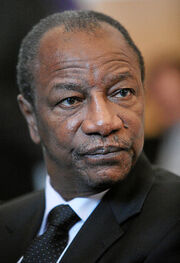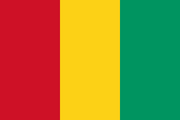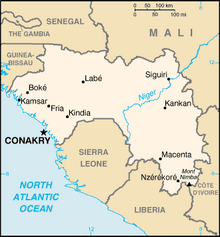| |||||
| Capital (and largest city) |
Conakry | ||||
| Other cities | Labe, Nzérékoré, Kankan, Kindia, Mamou, Boke, and Guéckédou. | ||||
| Language official |
French | ||||
| others | Mandinka, Fula and Susu | ||||
| Religion | 85% Muslim, 8% Christian, 7% animist. | ||||
| Government | Presidential Republic | ||||
| President | Alpha Condé | ||||
| Area | 246,000 km² | ||||
| Population | 8 million | ||||
| Established | independance from France-1958. | ||||
| Currency | West African Franc | ||||
Guinea, officially the Republic of Guinea (French: République de Guinée), is a country in West Africa. Formerly known as French Guinea (Guinée française), it is today sometimes called Guinea-Conakry to distinguish it from its neighbour Guinea-Bissau.
Guinea's 8 million people belong to twenty-four ethnic groups. The largest and most prominent groups are the Fula 35%, Mandinka 30%, and Susu 15%.
Guinea is surrounded by Mali, Senegal, Guinea Bissau, Sierra Leone, Ivory Coast, The Republic of Nimba and The Democratic Republic of Lofa
Pre-Doomsday History of Guinea[]
The land that is now Guinea belonged to a series of African empires until France colonized it in the 1890s, and made it part of French West Africa. Guinea declared its independence from France on 2 October 1958.
Guinea had the same President (Ahmed Sékou Touré) from independance until 1984. This was due to the fact that Guinea was a one party state and President Touré stood unopposed in the elections of 1961, 1968, 1974 and 1982.
Post-Doomsday History of Guinea[]
Soon after Doomsday refugees started arriving in Guinea from surrounding nations as they collapsed into anarchy, Sierra Leone, Guinea-Bissau and Liberia quickly fell into civil wars. Mali had its own problems with insurgents and its crackdown led to more refugees.
Guinea also had its own problems that were compounded by the influx of refugees from other nations, President Ahmed Sékou Touré of Guinea, ruled the nation by violent oppression, until 26 March 1984, when he died unexpectedly.
Following a brief coup d'état, Lansana Conté became the President after Touré. The constitution and parliament were suspended and a committee for national recovery was established.
President Conté died in unexplained circumstances in July 1995, it is possible that he had died of natural causes although rumours at the time suggest he may have been poisoned.
Since President Alpha Condé came to power in December 1996, the government of Guinea has been stable, as has the country.
There has, in the past, been cross border raids from Sierra Leone and particularly from the former nation of Liberia after their collapse into civil war, these raids however have stopped in recent years as stability has returned to those two areas.
Guinea became part of the West African Union in 2006.
Geography of Guinea[]
The country is divided into four main regions:
- The Basse-Coté lowlands, populated mainly by the Susu ethnic group.
- The cooler, mountainous Fouta Djallon that run roughly north-south through the middle of the country, populated by Fulas.
- The Sahelian Haute-Guinea to the northeast, populated by Malinké.
- The forested jungle regions in the southeast, with several ethnic groups.
Guinea's mountains are the source for the Niger, the Gambia, and Senegal Rivers, as well as the numerous rivers flowing to the sea on the west side of the range in Sierra Leone and Ivory Coast.
Trade and Industry in Guinea[]
Guinea has abundant natural resources including 25% or more of the world's known bauxite reserves. Guinea also has diamonds, gold, and other metals. The country has great potential for hydroelectric power. Other industries include processing plants for beer, juices, soft drinks and tobacco.
Agriculture employs 80% of the nation's labor force. Under French rule, and at the beginning of independence, Guinea was a major exporter of bananas, pineapples, coffee, peanuts, and palm oil.
International Relations[]
Guinea is a member of the West African Union, it has strong trade links with all its members.
It also has trade links with Mali, Sierra Leone and The Free Port of Monrovia as well as several smaller states in former Liberia including Republic of Nimba, Democratic Republic of Liberia and Democratic Republic of Lofa
Since the early 1990's, Guinea had been working with tribes in the north of former Liberia in order to secure Guniea's southern border from the chaos that had befallen the area of former Liberia and also the cross border raiding by former Sierra Leonians.
In particular the Kissi, Loma, Gbandi and Mendi tribes of Lofa County, who, with the help of Guniea, in 1998 helped found the Democratic Republic of Lofa.
Guniea had also offered assistance to the Gio and Mano peoples in former Liberian Nimba County, who themselves formed the The Republic of Nimba in 1996
History of the Politics of Guinea[]
Ahmed Sékou Touré became President upon Guinea's independence. By violent oppression, he ruled until 26 March 1984, when he died unexpectedly.
Following a brief coup d'état, Lansana Conté became the President after Touré. The constitution and parliament were suspended and a committee for national recovery was established.
Conté clung to power until his death in July 1995.
President of Guinea[]

President Condé
President Alpha Condé (born 4 March 1938) is a Guinean politician who has been President of Guinea since December 1996.
He was a political science professor at the University of Paris and spent decades in opposition to a succession of regimes in Guinea. Including during the reign of former Presidents Touré and Conté.
He has announced that in the elections of 2013 he will not be standing for the post of President.


